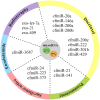The potential of cell-free and exosomal microRNAs as biomarkers in liquid biopsy in patients with prostate cancer
- PMID: 35922694
- PMCID: PMC11800841
- DOI: 10.1007/s00432-022-04213-9
The potential of cell-free and exosomal microRNAs as biomarkers in liquid biopsy in patients with prostate cancer
Abstract
Purpose: Prostate cancer (PCa) is the 4th most diagnosed cancer and the 8th leading cause of cancer-related death worldwide. Currently, clinical risk stratification models including factors like PSA levels, Gleason score, and digital rectal examination are used for this purpose. There is a need for novel biomarkers that can distinguish between indolent and aggressive pathology and reduce the risk of overdiagnosis/overtreatment. Liquid biopsy has a non-invasive character, can lead to less morbidity and provide new biomarkers, such as miRNAs, that regulate diverse important cellular processes. Here, we report an extended revision about the role of cell-free and exosomal miRNAs (exomiRNAs) as biomarkers for screening, diagnosis, prognosis, or treatment of PCa.
Methods: A comprehensive review of the published literature was conducted focusing on the usefulness, advantages, and clinical applications of cell-free and exomiRNAs in serum and plasma. Using PubMed database 53 articles published between 2012 and 2021 were selected and discussed from the perspective of their use as diagnostic, prognostic and therapeutic biomarkers for PCa.
Results: We identify 119 miRNAs associated with PCa development and the cell-free and exosomal miR-21, miR-141, miR-200c, and miR-375 were consistently associated with progression in multiple cohorts/studies. However, standardized experimental procedures, and well-defined and clinically relevant cohort studies are urgently needed to confirm the biomarker potential of cell-free and exomiRNAs in serum or plasma.
Conclusion: Cell-free and exomiRNAs in serum or plasma are promising tools for be used as non-invasive biomarkers for diagnostic, prognosis, therapy improvement and clinical outcome prediction in PCa patients.
Keywords: Biomarkers; Non-coding RNAs; Preclinical; Serum and plasma.
© 2022. The Author(s), under exclusive licence to Springer-Verlag GmbH Germany, part of Springer Nature.
Conflict of interest statement
The authors have non-financial interests to disclose.
Figures




Similar articles
-
Can a Liquid Biopsy Detect Circulating Tumor DNA With Low-passage Whole-genome Sequencing in Patients With a Sarcoma? A Pilot Evaluation.Clin Orthop Relat Res. 2025 Jan 1;483(1):39-48. doi: 10.1097/CORR.0000000000003161. Epub 2024 Jun 21. Clin Orthop Relat Res. 2025. PMID: 38905450
-
Screening for prostate cancer.Cochrane Database Syst Rev. 2013 Jan 31;2013(1):CD004720. doi: 10.1002/14651858.CD004720.pub3. Cochrane Database Syst Rev. 2013. PMID: 23440794 Free PMC article.
-
Cost-effectiveness of using prognostic information to select women with breast cancer for adjuvant systemic therapy.Health Technol Assess. 2006 Sep;10(34):iii-iv, ix-xi, 1-204. doi: 10.3310/hta10340. Health Technol Assess. 2006. PMID: 16959170
-
Use of classical and novel biomarkers as prognostic risk factors for localised prostate cancer: a systematic review.Health Technol Assess. 2009 Jan;13(5):iii, xi-xiii 1-219. doi: 10.3310/hta13050. Health Technol Assess. 2009. PMID: 19128541
-
The Potential of MicroRNAs as Prostate Cancer Biomarkers.Eur Urol. 2016 Aug;70(2):312-22. doi: 10.1016/j.eururo.2015.12.054. Epub 2016 Jan 22. Eur Urol. 2016. PMID: 26806656 Free PMC article.
Cited by
-
Low Magnetic Field Exposure Alters Prostate Cancer Cell Properties.Biology (Basel). 2024 Sep 19;13(9):734. doi: 10.3390/biology13090734. Biology (Basel). 2024. PMID: 39336161 Free PMC article.
-
Evolving insights in blood-based liquid biopsies for prostate cancer interrogation.Oncoscience. 2023 Nov 30;10:69-80. doi: 10.18632/oncoscience.592. eCollection 2023. Oncoscience. 2023. PMID: 38033786 Free PMC article.
-
The potential of miR-153 as aggressive prostate cancer biomarker.Noncoding RNA Res. 2022 Oct 13;8(1):53-59. doi: 10.1016/j.ncrna.2022.10.002. eCollection 2023 Mar. Noncoding RNA Res. 2022. PMID: 36329790 Free PMC article.
-
Free circulating versus extracellular vesicle-associated microRNA expression in canine T-cell lymphoma.Front Vet Sci. 2024 Aug 29;11:1461506. doi: 10.3389/fvets.2024.1461506. eCollection 2024. Front Vet Sci. 2024. PMID: 39268522 Free PMC article.
References
-
- Aghdam AM, Amiri A, Salarinia R et al (2019) MicroRNAs as diagnostic, prognostic, and therapeutic biomarkers in prostate cancer. Crit Rev Eukaryot Gene Expr 29:127–139. 10.1615/CritRevEukaryotGeneExpr.2019025273 - PubMed
-
- Alix-panabières C, Pantel K (2016) Clinical applications of circulating tumor cells and circulating tumor DNA as liquid biopsy. Cancer Discov 6:479–492. 10.1158/2159-8290.CD-15-1483 - PubMed
-
- Al-Qatati A, Akrong C, Stevic I et al (2017) Plasma microRNA signature is associated with risk stratification in prostate cancer patients. Int J Cancer 141:1231–1239. 10.1002/ijc.30815 - PubMed
Publication types
MeSH terms
Substances
Grants and funding
LinkOut - more resources
Full Text Sources
Medical
Research Materials
Miscellaneous

